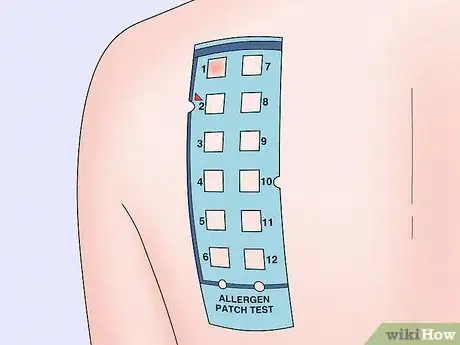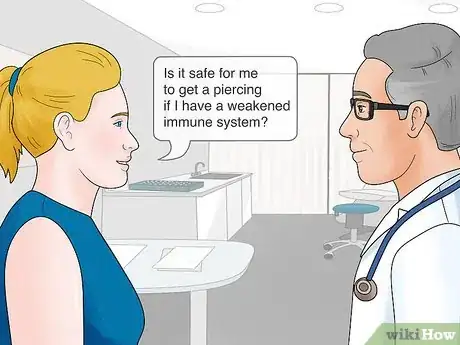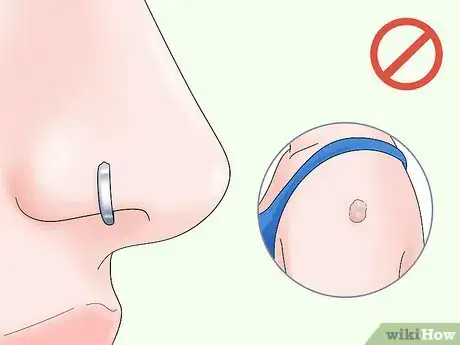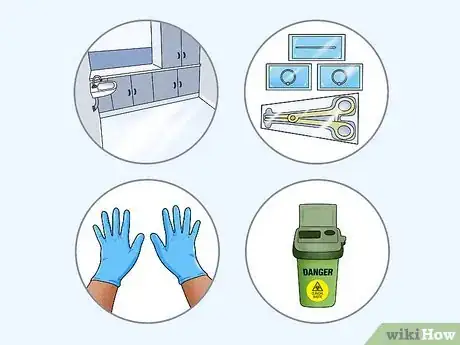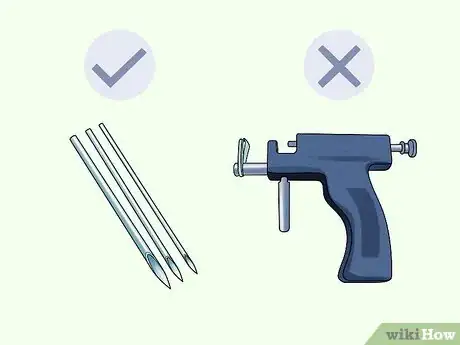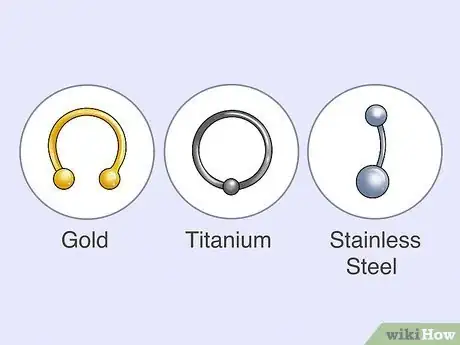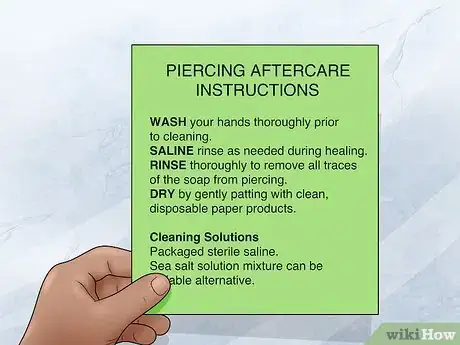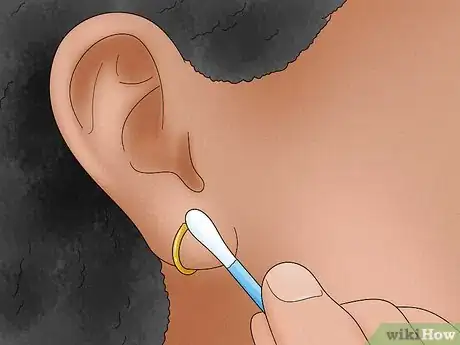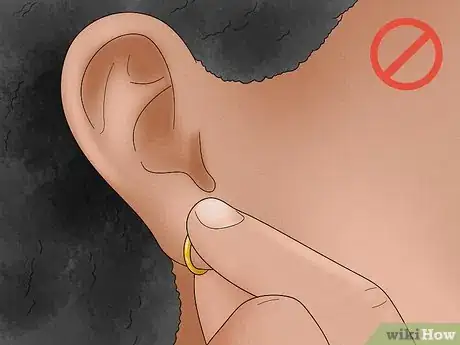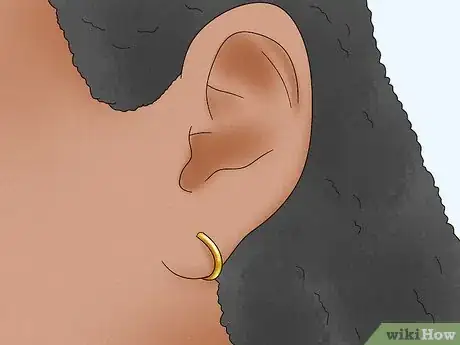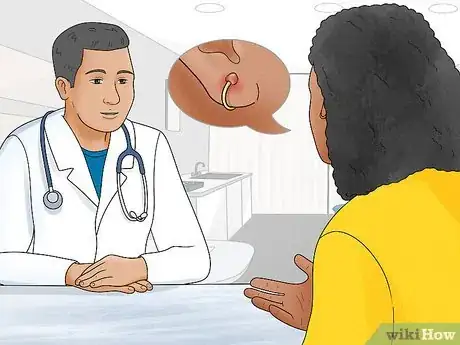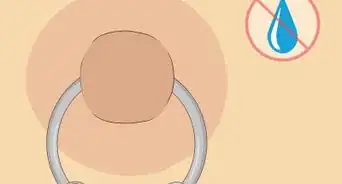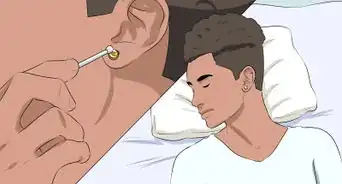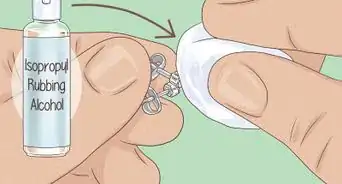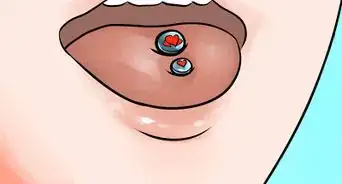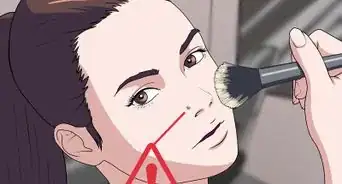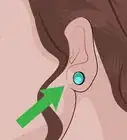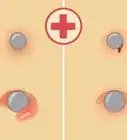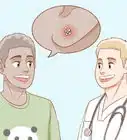This article was co-authored by Roger Rodriguez. Roger Rodriguez, also known as Roger Rabb!t, is the Owner of Ancient Adornments Body Piercing, a piercing studio based in the Los Angeles, California area. With over 25 years of piercing experience, Roger has become the co-owner of several piercing studios such as ENVY Body Piercing and Rebel Rebel Ear Piercing and teaches the craft of body piercing at Ancient Adornments. He is a member of the Association of Professional Piercers (APP).
This article has been viewed 12,637 times.
If you’ve ever gotten a piercing bump or seen it happen to someone else, then you probably want to do all you can to avoid it. These bumps are usually from irritation near a cartilage piercing, which could be caused by an infection, allergic reaction, or poor piercing technique. Luckily, preventing bumps isn’t hard to do. There is no guarantee that you won’t get a bump, since lots of different things could cause one. However, the right safety and sanitary steps can greatly reduce your risk for any complications from your piercing.
Steps
Safety Prep
-
1Get checked for any metal or plastic allergies before getting a piercing. One possible cause for a piercing bump is an allergic reaction to the piercing material, which causes dermatitis. Visit an allergist and get tested for allergies to common piercing metals like steel, titanium, gold, and tygon. If you have a reaction to any of these, avoid that material when you get your piercing.[1]
- If you know you have an allergy to something particular, be sure to inform your piercer about this so they don’t use that material.
- It’s also possible to have a reaction to the cleaning solution for your piercing.
-
2Ask your doctor if piercings are safe with a lowered immune system. Infections can also cause piercing bumps, and you’re much more prone to infections with a weakened immune system. All kinds of things can suppress your immunity, including diseases like HIV and hepatitis, certain medications, cancer treatments, and an autoimmune disorder. If you have any conditions that cause a weakened immune system, always talk to your doctor first to make sure getting a piercing is safe.[2]
- Your doctor might tell you that getting a piercing isn’t a good idea. In this case, listen to them to keep yourself safe.
- If you have any diseases that can spread through blood, like HIV or hepatitis, always inform your piercer before your appointment so they can take the right safety precautions.
Advertisement -
3Avoid piercings altogether if you’re prone to keloids. Keloids are overgrowths of scar tissue, meaning that even tiny injuries can cause large bumps on the skin. If you’ve had keloids before, then getting a piercing is not a good idea. You could develop a keloid at the piercing site.[3]
- If you still want a piercing, be sure to ask your doctor first. They can explain the risks and tell you if this is a good idea.
- You can still wear jewelry if you get keloids. There are no-pierce earrings that just clip onto your skin without any piercing.
Piercing Appointment
-
1Go to a licensed, professional piercer. These professionals are most likely to follow all the necessary safety and sanitary steps to keep you safe during your piercing. Investigate the piercer you’re considering using and make sure they have all the required state licenses to run a piercing shop. Don’t visit a shop that doesn’t have all of these licenses.[4]
- It’s also good to check reviews online. If some past customers have complained that they had a bad experience, it’s best to be safe and find another piercer.
- Always avoid home piercings, like letting your friend do it. This is very dangerous and it’s easy to get an infection or make a mistake like this.
-
2Confirm that the piercing establishment is clean and sanitary. Even a licensed professional might slip up, so always check that the studio is clean and sanitary before getting your piercing.[5] Some things to look for include:[6]
- Visibly clean surfaces like floors, counters, shelves, and sinks.
- Clearly labeled and separated piercing materials.
- Staff practicing good hygiene, including wearing gloves, washing their hands, and sterilizing chairs after a client sits in them.
- Disposal bins for used needles and tools.
- Never be shy about leaving the establishment if it doesn’t look clean to you. You might feel rude, but it’s much better than getting an infection.
-
3Make sure the piercer uses a needle instead of a piercing gun. The Association of Professional Piercers does not recommend piercing guns. They can cause a lot of damage and are prone to spread infections. Needles are much easier to clean and won’t cause nearly as much tissue damage, so make sure your piercer uses one for your piercing.[7]
- Most reputable piercers will use a needle anyway. If someone is using a piercing gun, it could mean they aren’t experienced, and it’s best to find another piercer.[8]
- It’s more common to see piercing guns at jewelry stores or other non-professional settings.
-
4Request a hypoallergenic metal for your piercing. Even if you don’t have a particular allergy, some materials are more prone to cause irritation than others. The best choices for piercings are surgical stainless steel, titanium, niobium, or gold. Make sure your piercer uses one of these materials for your piercing.[9]
- Most reputable piercers only use hypoallergenic materials anyway, but it’s always good to confirm this.[10]
- Bad choices for piercings include iron, low-grade steel, and plastic.
Proper Aftercare
-
1Follow all of your piercer’s directions for aftercare. A reputable piercing studio will give you a list of directions on properly cleaning and caring for your piercing until it heals. Read these instructions and make sure you understand them before leaving, then follow them to help your piercing heal.[11]
- Don’t hesitate to ask any questions if you’re not sure about the right aftercare steps. Feel free to call the studio if you have any questions later on.
-
2Clean your piercing every day to prevent infections. Wash your hands first to get rid of any bacteria. Then pour some sterile saline cleaning solution or soap and water onto a cotton swab and rub it around your piercing. Rinse the area when you’re done to get rid of any residue. Finish up by gently patting the area dry with a towel.[12]
- If you have a mouth piercing, like on your tongue, the best way to clean it is by swishing alcohol-free mouthwash around twice a day.
-
3Skip antiseptics or creams when cleaning your piecing. Harsh antiseptics like alcohol or peroxide actually irritate the area and could damage your skin. Antibacterial creams and ointments can attract dirt and prevent oxygen from getting into the wound. This is all bad for the healing process, so skip these options.[13]
-
4Avoid touching or playing with your piercing. This might be tempting, but do your best to resist. Touching the piercing could spread bacteria and irritate the area, causing bumps. Unless you’re cleaning the piercing, leave it alone.[14]
- If you do have to touch the piercing, be sure to wash your hands first.
-
5Leave the piercing in unless your doctor or piercer tells you to remove it. Your piercing could close up if you remove it before it’s healed, meaning you’ll need to get the area pierced again. More trauma could cause a bump, so leave the piercing in unless a professional tells you to take it out.[15]
- Even if your piercing gets infected, professionals recommend leaving it in through the healing period except as a last resort.
-
6See your doctor if you develop an infection. All piercings could potentially get infected, so keep an eye on yours. The main infection symptoms are increased pain, redness, heat, and pus around the piercing. You might also have a fever. If you see any of these signs, see your doctor right away.[16]
- The doctor will probably give you an oral antibiotic to knock out the infection and advise you to keep cleaning the piercing carefully.
Expert Q&A
-
QuestionHow do you speed up the healing process?
 Roger RodriguezRoger Rodriguez, also known as Roger Rabb!t, is the Owner of Ancient Adornments Body Piercing, a piercing studio based in the Los Angeles, California area. With over 25 years of piercing experience, Roger has become the co-owner of several piercing studios such as ENVY Body Piercing and Rebel Rebel Ear Piercing and teaches the craft of body piercing at Ancient Adornments. He is a member of the Association of Professional Piercers (APP).
Roger RodriguezRoger Rodriguez, also known as Roger Rabb!t, is the Owner of Ancient Adornments Body Piercing, a piercing studio based in the Los Angeles, California area. With over 25 years of piercing experience, Roger has become the co-owner of several piercing studios such as ENVY Body Piercing and Rebel Rebel Ear Piercing and teaches the craft of body piercing at Ancient Adornments. He is a member of the Association of Professional Piercers (APP).
Piercing Specialist Avoid twisting or turning the piercing. Moving your piercing around will prevent it from healing properly.
Avoid twisting or turning the piercing. Moving your piercing around will prevent it from healing properly.
Warnings
- If your piercing seems infected, then see your doctor right away.⧼thumbs_response⧽
References
- ↑ https://www.safepiercing.org/docs/Troubleshooting_Web.pdf
- ↑ https://kidshealth.org/en/teens/body-piercing-safe.html
- ↑ https://kidshealth.org/en/teens/body-piercing-safe.html
- ↑ https://www.mayoclinic.org/healthy-lifestyle/adult-health/in-depth/piercings/art-20047317
- ↑ https://www.safepiercing.org/safe_piercing_faq.php
- ↑ https://uhs.umich.edu/bodyart
- ↑ https://www.safepiercing.org/safe_piercing_faq.php
- ↑ https://uhs.umich.edu/bodyart
- ↑ https://www.mayoclinic.org/healthy-lifestyle/adult-health/in-depth/piercings/art-20047317
- ↑ https://uhs.umich.edu/bodyart
- ↑ https://www.safepiercing.org/aftercare.php
- ↑ https://www.safepiercing.org/aftercare.php
- ↑ https://uhs.umich.edu/bodyart
- ↑ https://www.mayoclinic.org/healthy-lifestyle/adult-health/in-depth/piercings/art-20047317
- ↑ https://www.safepiercing.org/docs/Troubleshooting_Web.pdf
- ↑ https://uhs.umich.edu/bodyart
- ↑ https://www.mayoclinic.org/healthy-lifestyle/adult-health/in-depth/piercings/art-20047317
